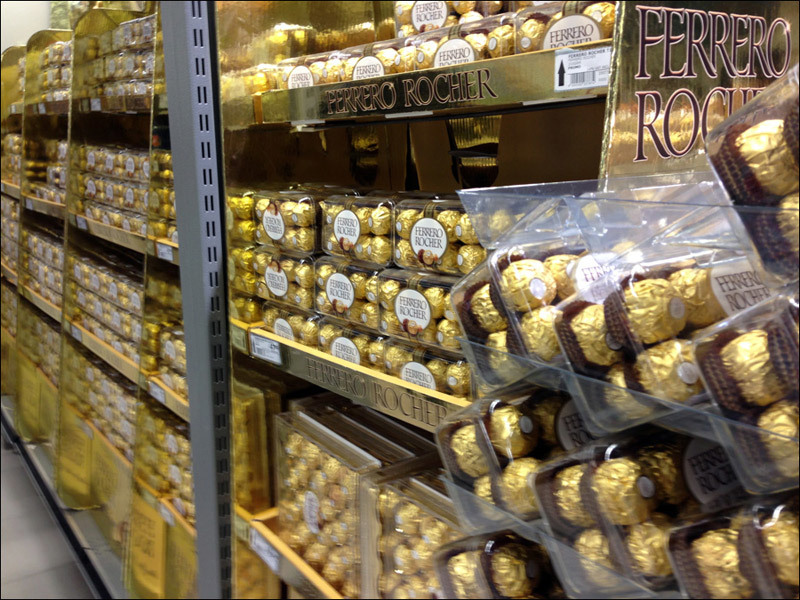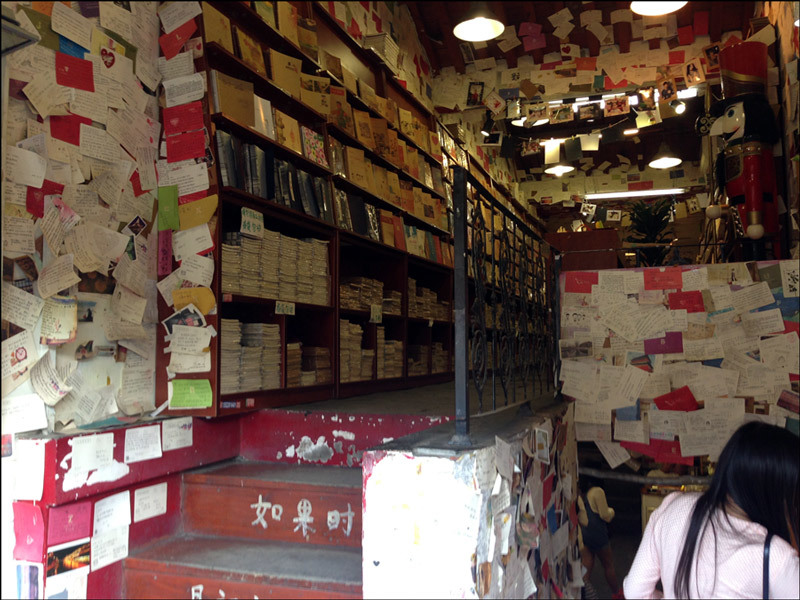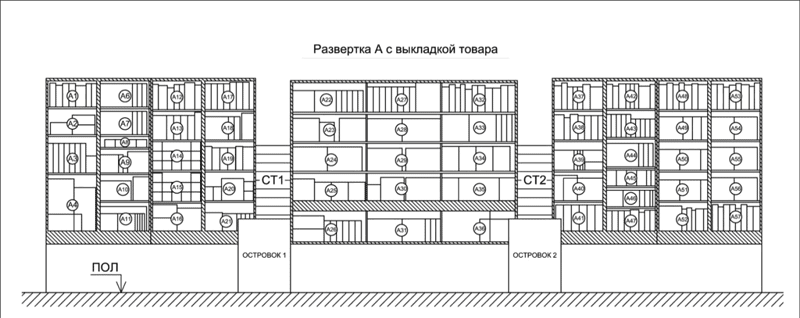Interface calculations (and a couple of small tips, how not to screw up, choosing a product)

When you open a refrigerator at home, there is a display interface that meets you - someone has a system, someone doesn’t, and someone keeps a barrel and socks there. So, in the store - display is where you see the product, where you take it to touch and where you often buy it.
Obviously, like any other interface in the real world, the layout takes into account the user's characteristics. Two hands, eyes above the grasping organs, attention deficit, and the dog rabies virus (more precisely, lack of time). Therefore, everything "by default" and sold most often lies exactly in front of you. More precisely, there, where you are accustomed to look at the product: the focus of the eye and the locus of the hands. That is, at chest level.
')
Perishable goods takes into account your laziness. Therefore, in a group of identical milk bottles, for example, the store is interested in selling you the closest to the deadline. She will lie first. The farthest will lie the freshest - they will take it last. Therefore, it may make sense to make a habit on autopilot to take something deeper on any cold shelves.
Main
The main principle of the calculation - more popular products closer to the focus of attention. Respectively:
- The most sold will be at the level of your chest (110-160 centimeters from the floor).
- A well-selling product will be a lot visually (it will get more shelf space).
- In order to attract attention, there will be a big price tag, something bright or something else like a separate promotional shelf.
- It is logical to place baby products below, because children are shorter.
- On the uppermost shelves rarely anyone looks in - more rare things are put in there. Look at the lower even less, so there is either a drive (most often), or something heavy (if the grocery cares about retirees, for example, or if retirees have already won a lawsuit about falling sack of flour on the head), or a non-priority item.

Example of recurring priority item in display, Waterfront, South Africa
The main question is what to put in the spotlight. You can choose the most popular product, you can choose the one you want to promote (for example, because the supplier paid or because you see the potential), but you can - the one that is most beneficial for you. These are most often three different competing products. Each store has its own mathematics, reduced to a compromise between these three things. Therefore, a simple rule: if you find an unfamiliar product that suits you, look carefully above and below. Most likely, there will be something cheaper with the same quality. As a rule, these are goods that either just hit the network and are priced for sales, or substitute goods of the same category without marketing agreements, or goods that have fallen out of the formula — for example, cheap sugar often hops so that a customer takes one that 10-15 rubles more expensive.
If you see a branded separate promotional shelf or a protruding stud on a regular shelving, this is a signal to ponder right away. As a rule, the store takes a lot of money from the supplier for such shelves when the goods inside for some reason are not sold by themselves from the usual places. Most often there are two solutions: either this is an all-Russia action on advertising with support on television and online, or somewhere close by is an analogue much cheaper, and you just have to find it.
Drives
There are three options to keep the goods in the store. More precisely, even more, if we consider the sale from a warehouse as in Ikea, or the sale without any goods at all, as in the market during the operational purchase. But the main three:
- Showcase and warehouse. The seller runs to the warehouse and makes you the same product, only another, without a price tag. Or replaces them with the one that you took, almost immediately. This is almost never used in its pure form on any type of open display.
- Drive on the shelf. This is when the right product for you is a few more pieces of the same. The only negative is in the thickness of the shelves, which can affect the width of the passage if the room is small. Well, you need a large stock of goods, otherwise the shelves will look half empty. Therefore, in very small stores do not.
- Drive at the bottom of the shelf. This is the most frequent case of shopping centers for our stores. The bottom blocks still almost do not attract attention in the layout, there are no utility rooms, the rooms are not the largest. We make the drive on the shelf for 4-5 games and put the rest in the lower boxes (which end just above the knee) - and the upper boxes, which sometimes begin above the outstretched hand. On Tverskaya, where the area is very, very small, even a collection of gift bags is made in one of these boxes. The buyer wants packaging - the box leaves, everything is there and right away.
The general case is balanced like this: drives in the shelves, small boxes up and down, a separate warehouse in the utility room for the most popular items. Naturally, this requires mathematics to determine the optimal reserves, and the calculation of logistics, and the right (often expensive) furniture to order. In the grocery, by the way, this is clearly visible: the drives in the shelves are large - there is self-service. At the same time, a special person in charge of the hall goes sometimes finishes the goods.

Beijing postcard shop. Below - drives, from which you can sell, above - an open display, even higher - shelves for something that did not fit.
The main error of the shelves is a hole in the layout. It should be immediately closed, even if it is another product.
The display can be open or closed. Obviously, an open one is better in all respects (to look into an aquarium instead of being able to hold it is nonsense), but local regional features do not allow making an open display, for example, a jeweler. Even the ABC of Taste, with its elite public, locks up expensive alcohol in the closet so that it is not stolen.
Here, the closed calculation is very justified.
Book with a closed display in the world is extremely small. Okay, and the books themselves every year less and less.
When the display is open, the product may fray, looking inside. A few clumsy boxes - and the shelf looks awful. We have this issue is relatively simple - almost every game has an open box. She lies second in the drive for a beautiful first. The first one is usually in the film, so it is not opened, but the second one is taken and tested - immediately after the first one is removed to look (or the seller gets it himself). Before the box is completely disrupted (while it still looks good), you need to have time to sell it at a discount and open a new one. Or write off the game fund. Completely killed boxes with whole contents are happy to take orphanages.
At one time, we also received samples of Ferbi (children's animal robots with minimal training and lots of features). They lay on a special shelf sticking out of the rack, and directly asked to hand. And one of the features of this thing - the reaction to external stimuli like Tamagotchi. As a result, by the evening, they all consistently switched to the “madness” or “aggression” mode, cursing, laughing and biting vilely. Each shift began the day with their hard reset. Before the non-commodity species, the animals were stabbed for a month - at some point it became scary to look at them, and we removed them.
Open display in Germany.
And finally, if you see “do not touch the goods with your hands,” and there is no open sample, then something is wrong. Usually, instead of such a plate, the seller opens the product and puts it in front (anyway, he already has an opened box by the time it comes to understanding that such a thing should be written). Or there at once trial goods, as in cosmetics - all the same one jar of perfume is sniffed out. If there is no such thing, either you see a one-day product, or there inside the shoals, for example, with a material.
Sort and Navigation
Navigation is important. Properly disassembled goods in the store help determine where and what. And immediately on large points such a plan is made, so that, for example, according to the grocery list, you go around everything, and you see a lot of temptations.
The principles of navigation can be conveniently considered a higher level, using the example of shopping centers entirely. The first generation is a bazaar with rows and dead ends. The second one is a ring, with entrance and exit in different places (especially I hate when escalators go up and down in different places on the floor), the third level is a spiral structure with free movement and maximum openness, but with calculated routes so that you are interested everywhere. We got up to eat, met two interesting shops on the way, saw the third one from the escalator and went around half the floor behind it - this is it. That such a structure creates with women is just hell, if the two of you come for one particular thing.
Such things are calculated according to the same principles as the optimal movements in the engineering interface are calculated by the eytracking. The world knows cases when one of the entrances was closed in the shopping center - and the number of sales grew by tens of percent. We have our own specific humor - for some reason, shopping centers sometimes solve this problem by closing toilets on the floor. At least one conscious case of such behavior of the administration, I know. As a Mega specialist correctly noted at the time, the punks had not visited them yet.
But back to the navigation. It is of two types - by category and by principles of use. By category - this is when the beer in the beer, and fish in the fish. By type of use - this is when beer and chips lie nearby. The most commonly used categorical display with individual promotional racks by type of use. It is important for us not to mix products from different categories, for example, if there are team games, you should not put a game for kids on the same shelf with them. This can be very disorienting for the buyer. On the other hand, we thought for a long time where to put things like “Answer me in 5 seconds” (insanely simple and fun quiz) - she, like, is sociable, and is suitable for playing in a family. For almost a year they duplicated, then they put in the company. Then the manufacturer realized our (and not only our) torment and released a separate children's version, different in color. In fact, doubled the already good sales, by the way.
A common mistake is placing goods in the “decompression zone”, that is, at the entrance or exit. The first 2-3 meters of the store a person gets used to it, and there he sees nothing at all.
The sweetest in navigation is the checkout area. You are guaranteed to get there. And there they steal less. Therefore, there lies a bunch of different little things and all spontaneous purchases. In the grocery principle is simple: if more than 4 people - it is a joint, if less than 2 - a reduction in check from the checkout and irrational burden on the seller. Therefore, endure. You have to buy there. Your wait is usually calculated so that you are not enraged, but the store does not spend more than necessary on the cashiers.
Summary
That's about it. The language of the calculations is universal all over the planet (except that in the Arab countries right and left places are changed, in China the breast level is lower than usual to us, and in the East there is almost no closed display, for example).
The display is done in our country, respectively, quite simply: the goods are beaten into categories for navigation, then sorted by priority (in our case, by turnover in 3 weeks) and laid out in racks. A separate plus receive promotional items and bright new items. Very hot product is laid out in a heap or basket outside the shelves (often happens closer to the holidays).

In the general case, we make planogram calculations so that sellers can decompose goods on them.
More security
- In the sales part of the calculations, be sure to check the price. In addition to super discounts, ordinary products can be included in “hot deals”. For example, in Pyaterochka there are special zones with promoted goods. Or there are shops where bright price tags (usual for discount goods) do not necessarily mean a discount.
- This product is put more expensive forward on the principle of contrast. If you do the opposite - the first price estimate will be understated, and will buy less. Accordingly, when you do not know the price of the desired product, it is psychologically more correct to walk from right to left.
- To the goods already familiar with advertisements on the right (in the Arab countries - on the left, along the reading line) new analogues are put. Similarly, in pharmacies to trustworthy drugs from the side can “hook” homeopathy, which, like, for the same symptoms.
- In shops with rare single goods it makes sense to ask for a product, even if you do not see it in the open display. It is possible that he is asked, but he is either heavily buried, or even inside a closed drive. If a person knows - they will give it, if he does not know - he will buy another, and the store will not spend a rare position.
Well, in combination with this story about what they are doing on their packaging, you can buy many things a little more safely.
Source: https://habr.com/ru/post/307256/
All Articles